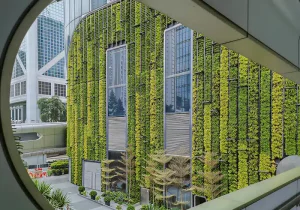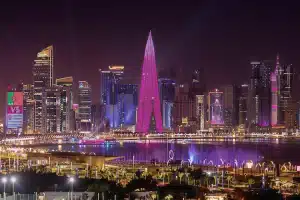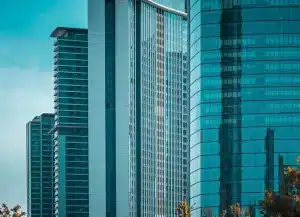
Green Building Trends: Aluminum vs. Stainless Steel for Living Façades
Green Building Trends: Aluminum vs. Stainless Steel for Living Façades As green building shifts from trend to standard, the building’s “skin” is undergoing a transformation.

The curtain wall, as the first look of modern buildings, it plays an important role in the fundamental functions like wind resistance, waterproofing, and thermal insulation. What’s more, it can also fully demonstrate the architectural aesthetics, energy efficiency, and construction efficiency. Different types of curtain wall systems can satisfy varying architectural needs. So making a well-structured classification is essential for architects, developers, and owners to quickly identify the most suitable solution.
Here, in this article, we will classify curtain wall systems based on three key dimensions: structural assembly method, visual presentation, and cultural functionality. We will also explore the characteristics and benefits of this classification approach, followed by a brief introduction and analysis of each curtain wall system category.
Curtain walls are typically categorized based on three key dimensions: structural assembly method, visual presentation, and functional characteristics. This classification system primarily considers the following factors:
– Unitized Curtain Wall: The prefabricated modular units are assembled in a factory , sot that it can realize the rapid on-site installation.
– Stick-built Curtain Wall (Exposed/Hidden Frame): Such curtain walls are assembled on-site, and the distinction of Exposed Frame and Hidden Frame just lines in whether its frame is visible or concealed.
– Point-supported Curtain Wall:
The mechanical fixings are used in such kind of curtain wall, but without a continuous frame, which can enhance the transparency.
– Exposed Frame Curtain Wall: The metal framework is visible, emphasizing structural lines.
– Hidden Frame Curtain Wall: The framework is concealed, creating a sleek glass façade.
– Point-supported Curtain Wall: Minimizes the presence of a frame, maximizing transparency.
– Masharabia: Classified separately for its cultural adaptability. Inspired by traditional Islamic architecture, it provides both shading and decorative functions.
– Features:
– Advantages:
✔ Shortens construction time and lowers on-site labor costs.
✔ More consistent quality control due to factory production.
✔ Ideal for super high-rise buildings and large commercial complexes.

Unitized Curtain Wall Installation for Pegasus Hotel in Guyana
Take Pegasus Hotel in Georgetown, Guyana as an example. Sunframe provides a complete unitized curtain wall system solution for it. The project is located on the coast of the Caribbean Sea and is in a tropical marine climate environment with high humidity, high salt and high wind pressure all year round, which places higher requirements on the weather resistance, air tightness and structural stability of the curtain wall system.
In this project, Sunframe uses a highly prefabricated unitized curtain wall system in the factory to ensure that each unit is assembled and airtight in a clean environment, greatly reducing the uncertainty of on-site construction. During the on-site installation process, the integrated unit was hoisted to effectively improve the construction efficiency, shorten the construction period, and maintain construction safety under high-altitude working conditions.
This project fully demonstrates the comprehensive advantages of unitized curtain walls in large international hotels, complex coastal environments, and high-rise rapid construction.

Airport Facade: CJIA Expansion Project
– Features:
– Advantages:
✔ Easy installation and low maintenance costs.
✔ Suitable for office buildings, commercial structures, and designs emphasizing structural expression.
✔ Allows flexibility in frame color and material selection for enhanced design versatility.
Taking the Cheddi Jagan International Airport (CJIA) expansion project in Georgetown, Guyana as an example, Sunframe provided a large-scale exposed frame curtain wall system solution for its new terminal. The project is located in a tropical monsoon climate zone with high temperature and high humidity throughout the year. As a transportation hub, the airport puts forward comprehensive requirements for the structural safety, lighting efficiency and long-term maintenance convenience of the building facade.
In this project, Sunframe adopts an exposed frame curtain wall system with clear structure and convenient installation, forming a clear and orderly curtain wall grille through exposed aluminum alloy vertical and horizontal keels. With large energy-saving glass units, it not only meets the requirements of the terminal for transparent and bright space, but also improves the wind pressure resistance and maintenance efficiency of the curtain wall system.
This project fully demonstrates the balanced advantages of the functionality, durability and design expression of the exposed frame curtain wall in large public buildings.
More about this curtain wall project for CJIA International Airport ››
– Features:
– Advantages:
✔ Sleek appearance, ideal for high-end office buildings and exhibition centers.
✔ Enhances architectural integrity and modern appeal.
✔ Can be combined with Low-E glass to improve energy efficiency.

M-PEACE PLAZA (MPP): SunFrame’s Contribution to Façade Engineering
Taking the M-Peace Plaza (Makuza Peace Plaza) commercial complex in Kigali, the capital of Rwanda, as an example, Sunframe provided a complete hidden frame curtain wall system solution for its tower. The project is one of the largest and most luxurious mixed-use buildings in Rwanda, integrating retail, office and high-end residential uses, with a total curtain wall area of about 11,000 square meters and a building height of up to 18 floors.
The climate of the project site is tropical savanna climate, with strong sunshine and concentrated rainy season, which puts forward multiple stringent requirements on the weather resistance, air tightness and visual effects of the curtain wall system. Sunframe adopts a full hidden frame solution, hiding all aluminum profiles behind the glass, and realizing a flat and transparent facade through the overall large glass surface. On the basis of ensuring the high performance of the curtain wall, the system enhances the modernity and elegance of the building facade, while achieving efficient waterproofness and structural stability.
The project is based on the positioning of urban landmarks and the construction of sustainable image. Its appearance is simple and the texture is clear, fully reflecting the application value and design expression of hidden frame curtain walls in high-rise commercial complexes.

QET-JMA: Innovative Aluminum Facade Solutions in Doha
– Features:
– Advantages:
✔ Effectively reduces direct sunlight exposure, optimizing energy efficiency.
✔ Distinct cultural identity, suitable for hotels, cultural centers, and heritage-inspired buildings.
✔ Customizable patterns for enhanced artistic expression.
Take the QET‑JMA project in Doha, Qatar as an example, Sunframe created a Musharbiya aluminum curtain wall system that combines tradition and modernity, with a total area of 1,014 square meters. The curtain wall pattern is derived from Islamic geometric aesthetics and is made of weather-resistant aluminum alloy. Through digital cutting and modular installation, the building takes into account sunshade, ventilation and cultural expression in extreme climates.
This project is not only the realization of a technical solution, but also a design response to light and shadow and faith space. And it has fully demonstrated the unique application value of Musharbiya curtain walls in religious and cultural buildings.
– Features:
– Advantages:
✔ Extreme transparency, enhancing natural lighting and views.
✔ Lightweight structure, suitable for large-span glass façades.
✔ Strong modern looking, ideal for landmark buildings.

Glass Facade Installation at Vigie Building Saint Lucia
Take the Vigie Building in Castries, Saint Lucia as an example. Sunframe provided the building with a solution of about 1,200 square meters of Point-supported curtain wall (Spider Glazing) and curved glass curtain wall system. The project is located in the tropical climate zone of the Caribbean region, and the building facade needs to cope with multiple climate challenges such as high temperature, strong ultraviolet rays, tropical storms and sea breeze corrosion.
In this project, Sunframe used a high-performance point-supported system, combined with a customized curved glass panel. The curve of the glass panel is natural and smooth, achieving the visual dynamics and structural stability of the space facade. SunFrame’s structural silicone sealing technology and precise position control ensure the airtightness and safety of the system. At the same time, the system has high construction precision and excellent installation efficiency. After completion, it not only meets the artistic expression of the building facade design, but also ensures weather resistance and convenient maintenance.
This project has shown SunFrame’s ability of point-supported curtain walls to combine structural simplicity with facade tension in modern architecture. What’s more, it is an ideal application case that emphasizes transparent and sculptural design.
Curtain wall systems are becoming the indispensable part in modern architecture, keeping aesthetics, functionality, and construction efficiency as a whole. We categorize them based on structural assembly, visual presentation, and cultural functionality just to make the selection more convenient for architects, developers, and building owners to serve their projects.
From unitized curtain walls that enhance building efficiency in high-rise buildings to exposed and hidden frame systems that offer varying levels of structural expression and sleek aesthetics, each type can satisfy distinct architectural needs. Masharabia, with its cultural significance and climate adaptability, shows a unique blend of tradition and performance. While point-supported systems push the boundaries of transparency and structural lightness.
As technology advances and sustainability becomes a key focus, curtain wall designs will continue to develop, integrating advanced materials and innovative engineering solutions. A great choice of curtain wall system not only enhances a building’s performance but also defines its architectural identity in the urban landscape.
For curtain wall projects, Sunframe is your expert in professional curtain wall solutions backed by AAMA, ISO, CSA (for aluminum windows & doors), and AS standards. So feel free to contact us anytime for customized solutions or technical consultations!

Green Building Trends: Aluminum vs. Stainless Steel for Living Façades As green building shifts from trend to standard, the building’s “skin” is undergoing a transformation.

Burj Al Mana Tower: The Story Behind Its Complex Façade and Engineering Rising over Doha’s West Bay, the Burj Al Mana Tower has a story

Every Detail Counts: Understanding SunFrame’s Product Pricing In the world of high-performance windows and curtain walls, every product has a clear cost logic behind it. At

How Spatial Utilization Drives Curtain Wall Selection —A Deeper Look into Light, Energy, and Space Introduction In modern architecture, curtain walls have moved beyond decoration